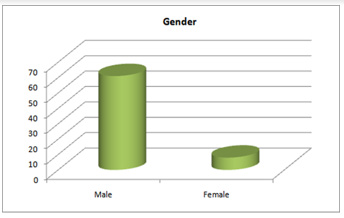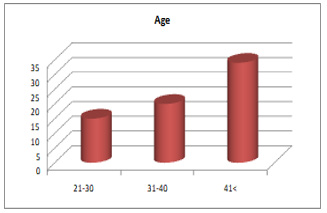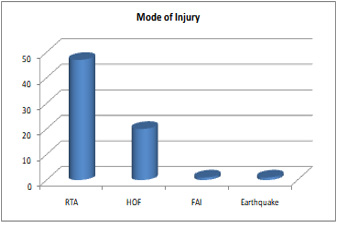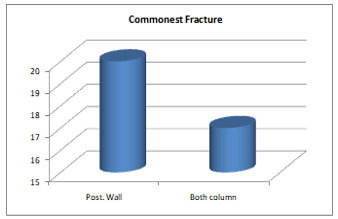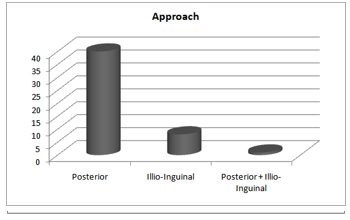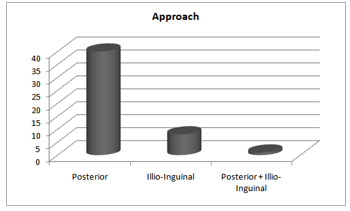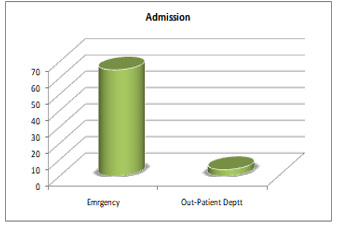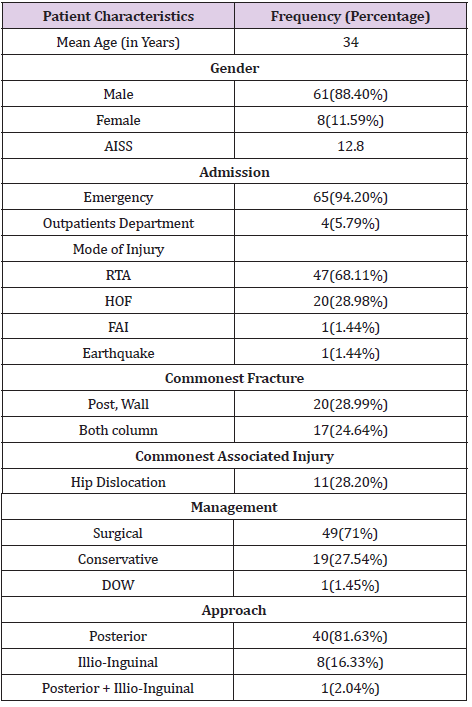Abstract
Objectives: The objective of this study was to know about the demographic characteristics of patients with acetabulum fractures, and to know about common associated injuries and various management methods in a teaching hospital of northern Pakistan.
Setting: the study was carried out at the department of Orthopaedics and spine surgery Hayatabad Medical Complex, Peshawar.
Study Design: Descriptive case series
Methods: All patients admitted to the department with acetabulum fractures were included in the study from January 2015 to December 2020. The patients were assessed and resuscitated, the demographic features noted, mechanism and severity of injury were recorded, and radiological evaluation including CT scans were done and fractures classified according to Judet and Letournel classification system. The operative details were recorded including surgical approach and fracture fixation.
Results: There were 69 patients in this study, 61 were male and 8 were female. Average age at the time of injury was 34 years and ranged from 22- 72 years. Out of our data pool 65 patients got admitted via Accident and Emergency and only 4 patients presented to our out-patient departmente-3]. Average Injury Severity Score at the time of injury was calculated to be 12.8. Commonest mechanism of injury was reported to be high energy trauma 62(89.8%). Road traffic accident was the commonest mode of injury i.e. 47(68.11%) According to the Letournel classification, two fracture types were most common i.e. posterior wall fracture 20 (28.99%) and both column fracture 17(24.64%). Thirty nine patients had associated injuries out of which injured hip dislocation was prevalent i.e.11(28%). Open reduction and internal fixation was the preferred management for 49(71%) patients while 19(27.54%) patients were conservatively managed. Out of those that were surgically managed 40(81%) patients fracture was approached via Kocher-langenbeck approach.
Conclusions: Acetabular fractures are common in young adults and the most common mechanism of injury is road traffic accidents. The common fractures are posterior wall and both column injuries and associated with hip dislocation. The preferred method of treatment is surgical fixation through Kocher langenback approach.
Keywords: Fracture Acetabulum; Hip Dislocation; Associated Injuries
Introduction
The acetabulum is a cup shaped depression on the outer surface of the hip bone and it articulates with the head of the femur. Acetabular fractures occur when the head of femur is pushed into the pelvis by a lateral blow to the hip or by an anterior blow to the knee with hip in flexion and abduction [1]. Acetabulum fracture has rare incidence of about 5/100,000 people per year, as compared to proximal femur fractures, which has about a hundred times higher incidence, based on geographical areas [2]. However, this rate is on the rise worldwide as a result of increase in road traffic accidents and high impact injuries1.About 80% of acetabular fractures result from high energy trauma like in road traffic accidents and around10.7% result from fall from a significant height [3]. Acetabulum fracture present more often in multiple trauma patient and are considered as serious injury [3]. Patients present to emergency department with history of pain or a hip deformity, usually with other associated injuries such as hip dislocation, femoral neck fracture or sciatic nerve palsy. They can also present with trauma to the surrounding structures like peri-pelvic soft tissues, extremity fractures, trauma to major abdominal viscera and chest injuries [4]. Pelvic insults can be diverse, ranging from minor lacerations to major debilitating complex acetabular fractures [4]. Different factors are associated with mortality and morbidity of patient including mechanism and the energy of initial insult, age, male gender, cardiac diseases, dementia, institutionalization and rehabilitation. That should be carried out after hip trauma and plays a significant role in patient recovery [5-7].
In general, operative treatment of an acetabular fracture should not be performed as an emergency except when it is a part of open fracture management or is performed for a fracture associated with an irreducible dislocation of the hip. In such cases, the top priority would be resuscitation followed by Advanced Trauma Life Support protocols [8]. The aim of our study is to assess the pattern of acetabulum fractures presenting to our unit and the injuries they are associated with in relation to the initial mechanism and severity of trauma.
Methods
This study is a case series for which data was collected from the Department of Orthopedics & Spine Surgery Hayatabad Medical Complex Peshawar. Patients who met the inclusion criteria from January 2015 to December 2020 were selected. The inclusion criteria consisted of adult patients with traumatic acetabular fracture. The exclusion criteria included pediatric patient with traumatic acetabular fracture, pathologic acetabulum fracture, periprosthetic acetabulum fracture and patients who were previously operated on the same hip joint. All patients were admitted under the care of consultant orthopedic surgeon and were operated on a dedicated list .Data was analyzed using SPSS version 22 .Cross tabulations were made and recorded where required.
Results
We included 69 patients in this study, out of which 61 were male and 8 were female (Figure 1). In our study 15 patients were between the age of 21-30, 20 patients were between the age of 31- 40 and the rest of 34 were from the age group of above 40. The youngest patent was of 22 years of age, while the oldest one was of the age of 72 in our study. Average age at the time of injury was 34 years (Figure 2). Out of our data pool 65 patients got admitted via Accident and Emergency and only 4 patients presented to our out-patient departmente-3]. Average Injury Severity Score at the time of injury was calculated to be 12.8. Commonest mechanism of injury was reported to be high energy trauma 62(89.8%). Road traffic accident was the commonest mode of injury i.e., 47(68.11%) (Figure 3). According to the Letournel classification, two fracture types were most common i.e., posterior wall fracture 20 (28.99%) and both column fracture 17(24.64%) (Figure 4). Thirty-nine patients had associated injuries out of which injured hip dislocation was prevalent i.e.11(28%). Open reduction and internal fixation was the preferred management for 49(71%) patients while 19(27.54%) patients were conservatively managed, depending upon the severity of fracture, joint incongruity and patient fitness for anesthesia (Figure 5). Out of those that were surgically managed 40(81%) patients fracture was approached via Kocher-langenbeck approach (Figure 6). The results presented in Table 1 (Figure 7).
Discussion
Acetabular fractures are serious orthopedic injuries and they can prove to be a complex surgical issue. In our study the most common cause for acetabular fracture was the road traffic accident (RTA).68.11% cases were accounted due to RTA. The rest was injured due to history of fall from height. The results were comparable with Hussain et al 1, where 83% cause for the acetabular fractures was RTA in their study. The second most common in their study was fall which is similar to our study. The study results shows that the acetabular fractures was in higher frequency in male due to their style of work and the frequency was low in the females. 88% injuries were accounted in males. The results are similar to the study by Giannoudis, et al. [3] where injuries were mostly accounted for males. The study found that the mean age for the patient was 34 years, which was similar to other studies [9]. The current study found that two fracture types were most commonly presented i.e. posterior wall fracture20(28.99%)and both column fracture17(24.64%).Thirty-nine patients had associated injuries out which injured hip dislocation was prevalent i.e. 11(28%). The same were also experienced in their study by Hussain, et al. [1]. In our study we found that open reduction and internal fixation was the preferred and major management practices for the patient. According to study 71% cases was fixed using open reduction and internal fixation. The same was similar with the study of (S. Hoge and B. J 2019) [10] who found that most of the fracture required open reduction and internal fixation. Similar operation rate were reported by other authors [11-13,14]. The study found that out of those patients who were surgically managed 81% patients’ fracture was approached via Kocher-langenbeck approach, which almost similar to the rates in literature [14-17].
Conclusion
Acetabular fractures are common in young adults and the most common mechanism of injury is road traffic accidents. The common fractures are posterior wall and both column injuries and associated with hip dislocation. The preferred method of treatment is surgical fixation through Kocher langenback approach.
References
- KSA Hussain, NR Kancherla, SK Kanugula, C Patnala (2016) Analysis of displaced acetabular fractures in adults treated with open reduction and internal fixation. Int J Res Orthop 2(3): 99-103.
- O Johnel, B Gullberg, E Allander, JA Kanis (1992) The apparent incidence of hip fracture in Europe: a study of national register sources. Osteoporos Int 2(6): 298-302.
- PV Giannoudis, MRW Grotz, C Papakostidis, H Dinopoulos (2005) Operative treatment of displaced fractures of the acetabulum: a meta-analysis. J Bone Joint Surg Br 87(1): 2-9.
- D Demetriades, M Karaiskakis, GC Velmahos, K Alo, J Murray, et al. (2003) Pelvic fractures in pediatric and adult trauma patients: are they different injuries? J Trauma Acute Care Surg 54(6): 1146-1151.
- F Hu, C Jiang, J Shen, P Tang, Y Wang (2012) Preoperative predictors for mortality following hip fracture surgery: a systematic review and meta-analysis. Injury 43(6): 676-685.
- BSL Riska, L Forsén, TK Omsland, AJ Søgaard, HE Meyer, et al. (2018) Does the association of comorbidity with1‐year mortality after hip fracture differ according to gender? The Norwegian Epidemiologic Osteoporosis Studies (NOREPOS). J Am Geriatr Soc 66(3): 553-558.
- YC Ha, YG Park, KW Nam, SR Kim (2015) Trend in hip fracture incidence and mortality in Korea: a prospective cohort study from 2002 to 2011. J Korean Med Sci 30(4): 483.
- JJ Halvorson, Jeremy Lamothe, C Ryan Martin, Andrew Grose, David E Asprinio, et al. (2014) Combined acetabulum and pelvic ring injuries. JAAOS-Journal Am Acad Orthop Surg 22(5): 304-314.
- T Panagiotis, P Elias, M Constantinos, T Minos, D Panagiotis, et al. (2007) Long-term results in surgically treated acetabular fractures through the posterior approaches. J Trauma Acute Care Surg 62(2): 378-382.
- S Hoge, BJ Chauvin (2019) Acetabular fractures. In: S Hoge, BJ Chauvin (Eds.)., StatPearls Publishing, USA.
- SD Deo, SP Tavares, RK Pandey, G El Saied, KM Willett, et al. (2001) Operative management of acetabular fractures in Oxford. Injury 32(7): 581-586.
- NB Antell, JA Switzer, AH Schmidt (2017) Management of acetabular fractures in the elderly. JAAOS-Journal Am Acad Orthop Surg 25(8): 577-585.
- A Kumar, NA Shah, SA Kershaw, AD Clayson (2005) Operative management of acetabular fractures: a review of 73 fractures. Injury 36(5): 605-612.
- W Lehmannetal, Michael Hoffmann, Florian Fensky, Jakob Nüchtern, Lars Großterlinden, et al. (2014) What is the frequency of nerve injuries associated with acetabular fractures? Clin Orthop Relat Res 472(11): 3395-3403.
- BG Ochs, Ivan Marintschev, Heike Hoyer, Bernd Rolauffs, Ulf Culemann, et al. (2010) Changes in the treatment of acetabular fractures over 15 years: analysis of 1266 cases treated by the German Pelvic Multicentre Study Group (DAO/DGU). Injury 41(8): 839-851.
- R Firoozabadi, TJ Omara, A Swenson, J Agel, JD Beck, et al. (2014) Risk factors for the development of heterotopic ossification after acetabular fracture fixation. Clin Orthop Relat Res 472(11): 3383-3388.
- E Letournel (2007) Acetabulum fractures: classification and management. Orthop Trauma Dir 5(05): 27-33.

 Short Communication
Short Communication